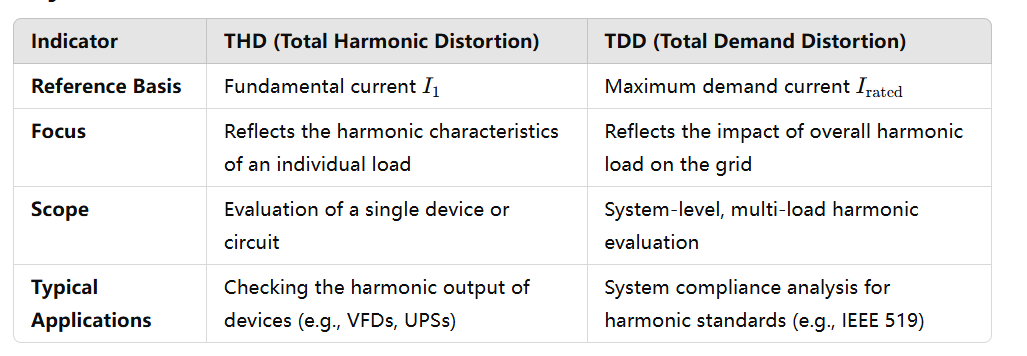
Que sont le TDD et le THD ? — Une explication complète des indicateurs de distorsion harmonique
Dans les systèmes électriques et la gestion de la qualité de l'énergie, la distorsion harmonique est un problème crucial qui ne peut être ignoré. Deux indicateurs clés utilisés pour mesurer la distorsion harmonique sont le THD (Total Harmonic Distortion) et le TDD (Total Demand Distortion). Ces termes sont couramment référencés dans les spécifications techniques et servent de références essentielles dans la conception, l’exploitation et la maintenance des systèmes électriques.
THD (distorsion harmonique totale)
Définition
THD fait référence à la représentation en pourcentage des courants ou tensions harmoniques par rapport à l'onde fondamentale. Il quantifie la proportion de composantes harmoniques dans la forme d'onde. La formule de calcul est :

Où :
I1 est le courant fondamental,
I2, I3,In sont les courants harmoniques.
Importance
Le THD est principalement utilisé pour mesurer le degré de distorsion harmonique dans une charge spécifique. Il est directement corrélé à la charge particulière ou à la qualité de l'énergie, servant d'indicateur important des performances de l'équipement et de la qualité de l'énergie.
Scénarios d'application
THD est plus adapté à l'évaluation des harmoniques d'un seul appareil ou d'un circuit spécifique. Par exemple :
- Vérification du contenu harmonique d'un variateur de fréquence (VFD) ;
- Test de la qualité de la tension de sortie d'une alimentation sans interruption (UPS).
---
TDD (distorsion totale de la demande)
Définition
TDD fait référence au rapport entre le courant harmonique total et le courant de demande maximal du système (généralement le courant nominal ou la charge maximale du transformateur), reflétant l'impact global de la distorsion harmonique sur le réseau. La formule de calcul est :

Où :
Irate est le courant nominal ou le courant de demande maximum du système.
Importance
Le TDD met l'accent sur l'impact des charges harmoniques sur l'ensemble du système et est plus adapté à l'évaluation du niveau d'harmoniques dans des conditions de fonctionnement multi-charges, étroitement associées à la capacité du système.
Scénarios d'application
TDD est plus adapté à l'analyse harmonique au niveau du système, telle que :
- Évaluation de la charge harmonique totale lorsque plusieurs appareils fonctionnent sur le réseau ;
- Déterminer si le réseau est conforme aux normes harmoniques (par exemple, les exigences IEEE 519-2014).
---
Différences clés entre THD et TDD

Comment réduire les THD et TDD ?
Les méthodes permettant de réduire la distorsion harmonique comprennent principalement :
1. Installer des dispositifs d'atténuation des harmoniques
- Filtres d'harmoniques actifs (AHF) : surveillance et compensation en temps réel des harmoniques.
- Générateurs de variables statiques (SVG) : améliorez le facteur de puissance et optimisez les harmoniques.
2. Choisissez des appareils à faibles harmoniques
Utilisez un équipement électrique conforme aux normes internationales en matière d'harmoniques (par exemple, IEEE 519 ou GB/T 14549).
3. Optimiser la conception du système
- Augmenter la capacité du système pour réduire l'impact proportionnel des harmoniques ;
- Configurer correctement les charges pour empêcher l'accumulation des sources d'harmoniques.
4. Surveillance et maintenance régulières
Suivez en continu les THD et TDD à l'aide d'analyseurs d'harmoniques ou d'équipements de surveillance de la qualité de l'énergie, et effectuez des ajustements en temps opportun.
---
Conclusion
THD et TDD sont deux indicateurs importants pour mesurer la distorsion harmonique, chacun avec son objectif et sa portée applicable. Le THD est mieux adapté à l'analyse d'un appareil ou d'un circuit individuel, tandis que le TDD est utilisé pour l'évaluation des harmoniques au niveau du système. En utilisant efficacement ces deux indicateurs, on peut améliorer considérablement la stabilité et l’efficacité des systèmes électriques.
Si vous recherchez des solutions efficaces d'atténuation des harmoniques, pensez au filtre harmonique actif (AHF) et au générateur de var statique (SVG) de YT Electric, qui peuvent vous aider à gérer la compensation des harmoniques et de la puissance réactive de manière efficace et fiable.
abonnez-vous à nous pour profiter des prix des événements et obtenir certains des meilleurs prix.
 réseau ipv6 pris en charge
réseau ipv6 pris en charge

